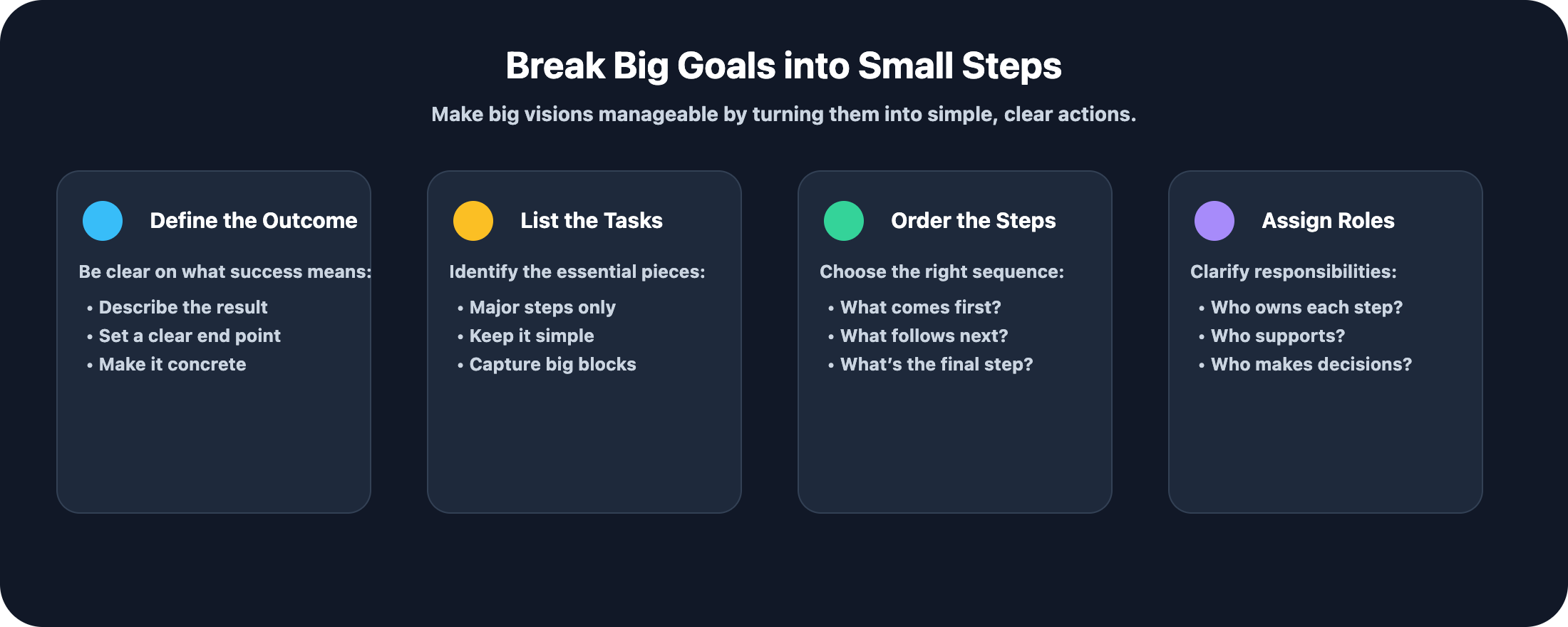Bringing a shared vision to life requires more than just agreement on goals—it demands that everyone can see, feel, and understand what success looks like. When you make the vision tangible, you transform abstract ideas into something people can rally around, act on, and believe in. This clarity fuels motivation and helps groups move from intention to action.
A vision becomes real when people can picture it in their minds. Instead of relying on vague statements, use concrete examples or short stories to illustrate what the future could look like. For instance, rather than saying, "We want to make our campus event more successful," paint a picture:
"Imagine students walking into the event and immediately feeling welcomed, with music playing, people chatting, and everyone finding something they’re excited about. By the end, people are already asking when we’ll do it again."
This kind of scenario helps everyone see the end goal, not just the process.
You can also use storytelling to connect the vision to real people and outcomes. For example:
"Last year, a lot of people left early because there wasn’t much to do. This time, we want everyone to stay until the end because they’re having such a good time and feel included."
Stories like these make the vision memorable and emotionally resonant, helping people understand why the goal matters.
A compelling vision can feel overwhelming if it’s too big or abstract. To make it actionable, break it down into clear, manageable steps. First, you'll define the outcome. Then, list the tasks that need to be done and in what order. Finally, you'll assign roles to the tasks.

This approach transforms a lofty goal into a series of achievable milestones, making progress visible and momentum sustainable.
When you outline these steps, remember to use inclusive language that reinforces shared ownership: "Our first milestone is to finalize the activity list together. Then, we’ll all check in next week to see how things are going and make any changes we need." This keeps everyone engaged and invested in each phase of the journey.
To truly inspire action, help people visualize the impact of success. Describe what will be different—how it will feel, what participants will experience, and how the group will benefit. You can also highlight how individual contributions fit into the big picture.
Often, the process of making a vision tangible happens in conversation, as people share ideas and build on each other’s excitement. When group members talk through what success could look like and how to get there, the vision becomes real and motivating for everyone involved. Here’s how this might sound in practice:
Nova: I know we want the event to be better this year, but what does that actually mean?
Victoria: Picture this: People walk in and immediately feel at home—there’s music, games, and everyone’s chatting. By the end, no one wants to leave because they’re having such a good time.
Nova: That sounds awesome, but how do we make it happen?
Victoria: We’ll start by picking a theme and planning out a few activities. Then, we’ll each take on something we’re excited about—like you handling decorations and me making the playlist. We’ll check in each week to see how it’s going and help each other out.
Nova: I love that! I can already picture how the room will look with the decorations. It feels way more doable when we break it down.
Notice how Victoria uses a simple scenario to make the vision concrete, breaks the big goal into actionable steps, and paints a picture of what success will look like for everyone involved.
By mastering the skill of making a vision tangible, you turn abstract goals into something real and motivating for everyone involved. Using vivid examples, breaking big goals into small steps, and talking through what success will look like helps people see their role and get excited about the outcome. When a group can clearly picture both the path and the destination, they’re far more likely to stay engaged, take action, and achieve their shared vision together. In the upcoming exercises, you'll have a chance to practice these skills.
